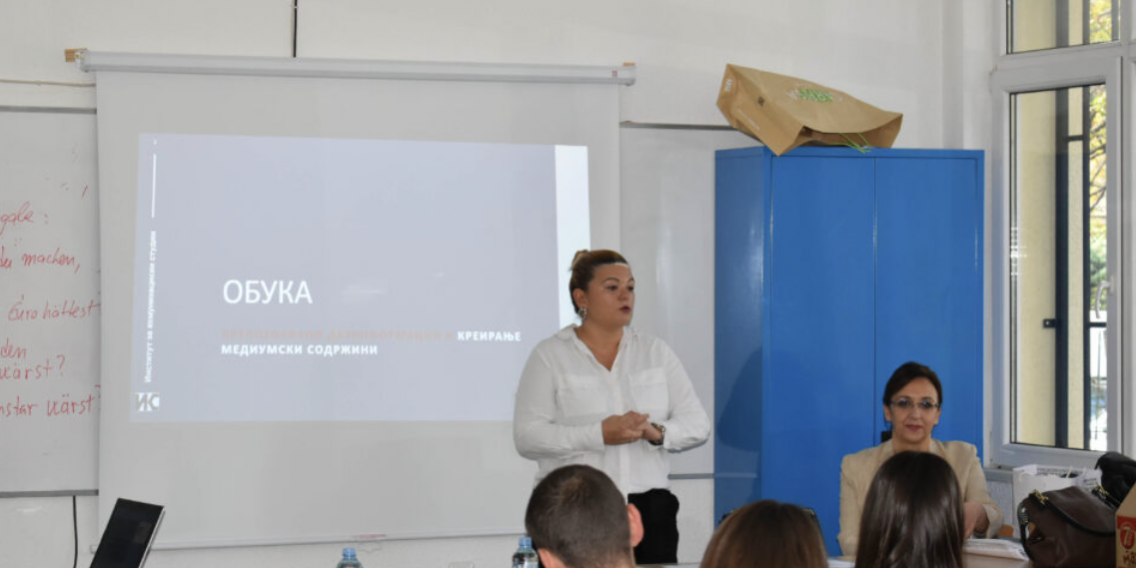High-school students have the skills to spot disinformation that, as they say, they grew up with; however, it still happens that some of them “slip” and share or fall for a certain manipulation. Their impression is that disinformation are massively present on all social networks, and to check these, they use different techniques starting from checking the source and who wrote and shared the news, and whether the news has been shared by other media, to whether the news has relevant sources.
Mila Arsovska, a high-school student from the “Goce Delchev” High School from Kumanovo, says that she has a sharp eye and can immediately spot disinformation, although she admits “there are some disinformation that are made to sound so truthful and I check to find out if they are fake or come from an official website before I trust them.” She says she has never shared disinformation before, but that it often happens to her classmates who share fabricated news within their school groups, such as, for instance, the fake bomb alerts or the information about sales of cheaper concert tickets which had turned out to be “fake”, etc.
Gjorgi Zlatevski, who is a third-year student at the same high school, says that he grew up with disinformation and that, faced with it every day, he had learned how to spot it.
“I can recognize most of the disinformation, but now, with the help of artificial intelligence, it is easier to create and spread these faster. I think that nowadays there is more disinformation. It happens that I still trust some disinformation, but I have learned to look for the facts in the text. I still do not check photos,” he says.
The students of the “Georgi Dimitrov” High School in Skopje shared a similar experience. They say that the process of recognizing disinformation has been made more difficult by AI, which is used to create manipulative videos or photos.
“In my daily life, I often come across fake news about famous people, which I can recognize by using my logic or by doing more research to get to the answer. Artificial intelligence facilitates the creation of fake news, and therefore the exercises we performed in the workshop were interesting and educational,” says Filip Karfilovski, a high-school student of SUGS “Gorgi Dimitrov” from Skopje.
Disinformation and the tools for spotting visual manipulations were the topics discussed at the two media labs titled “Spotting Disinformation and Creating Media Content”, organized by the Institute of Communication Studies in “Goce Delchev” High School in Kumanovo and “Georgi Dimitrov” High School in Skopje. The high-school students had an opportunity to create journalistic stories and practice mobile journalism, record and edit material using mobile phones.
“We, the young people, know how to spot frauds on the Internet, but I must admit that it is becoming more and more difficult. The training really helped us understand the fact-checking techniques and tools, which is of great importance. The combination of lectures and hands-on exercises at this workshop helped me gain a deeper understanding of the challenges we face. I particularly enjoyed the writing exercise, which I feel has improved my understanding and prompted me to be more critical of the content I consume and share. The recording exercise was also interesting and gave us new insight into how to convey messages properly.
“In addition, we addressed the role of artificial intelligence – a topic on which I personally have divided opinions. AI’s ability to manipulate text and images makes it harder to discern what is true. Therefore, workshops as this are extremely useful because they help us to become more literate in the digital world and to be more responsible when sharing information,” says Ivana Sarevska, fourth-year student of the “Georgi Dimitrov” High School.
The high-school students agree that the most important tool to stop the spread of disinformation and other media manipulation in the digital world is to think critically and logically about the news that reach them before deciding whether to trust it and share it.
The media lab on spotting disinformation and creating media content was organized as part of the 2024 Media Literacy Days, organized by the Media Literacy Network.
These workshops are organized as part of the project called “Use Facts”, supported by the British Embassy in Skopje, and are part of the activities of the UNESCO Chair of Futures and Media Information Literacy, at the ICS.






